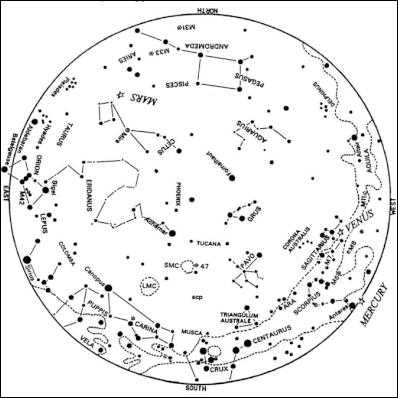Brian Carter: The Night Sky In November
THE NATIONAL OBSERVATORY OF NEW ZEALAND
THE NIGHT SKY
Brian Carter*
THE NOVEMBER NIGHT SKY
In the Summer months with warmer nights, looking at the stars and planets becomes a pleasure, instead of a cold ordeal.
Planets
November is a fairly good month for viewing the planets. Venus, Mars and Saturn will be visible for the whole of the month. Mercury will be visible for the first half of the month and Jupiter will be visible for the last half of the month.
Mercury will be visible for the first half of November. At the start of the month it sets at 22:09, by November 19 at 21:24 (an hour after Sunset) and by November 25 it sets at the same time as the Sun. Mercury starts the month in the constellation of Scorpius, moving into Ophiuchus on November 8, back into Scorpius on November 21 and finally into Libra on November 25. Its magnitude rapidly fades from ¡V0.2 to 1.9 by November 19 and to 5.3 by November 25.
Venus can be seen in the evening sky. At the start of the month it sets at 00:09 and by the end of the month at 23:58. Venus starts the month in the constellation of Ophiuchus, moving into Sagittarius on November 2. Its magnitude slightly brightens from ¡V4.4 to ¡V4.6, making it easier to see in the evening twilight as the ¡§Evening Star¡¨.
Mars will be visible for all of the night except for the very end towards the latter part of the month. By November 9 Mars sets at Sunrise and by the end of the month at 04:20. Mars is in the constellation of Aries, in which it remains until 2006 February. It starts the month at its brightest magnitude for the year of ¡V2.3 (outshining Jupiter) and fades to ¡V1.7 by month¡¦s end.
Saturn will be visible for the last third of the night. At the start of November it rises at 02:38 and at 00:45 by month¡¦s end. Saturn is in the constellation of Cancer, in which it remains until September 2006. Its magnitude slightly brightens from 0.3 to 0.2 during the month.
Jupiter will be visible for the last half of November. By November 21 it rise at 04:49 (an hour before Sunrise) and by the end of the month at 04:18. Jupiter is in the constellation of Virgo. Its magnitude is a constant ¡V1.7 during the month.
All times are for Wellington unless otherwise stated. Other centres may vary by a few minutes.
Phases of the Moon

Click for big version
Diary of Astronomical Phenomena
Nov 2 New Moon at 14:25.
4 Mercury at
greatest Easterly elongation from the Sun (24„a) at
05:00.
4 Venus at greatest Easterly elongation from the
Sun (47„a) at 08:00.
4 Moon close to Antares in the early
evening twilight.
7 Mars at opposition (on the opposite
side of the Earth to the Sun) at 21:00.
9 & 10 Mercury
close to Antares in the evening twilight.
10 Moon at
perigee (closest to the Earth) at 13:00. (Distance =
0.0024734 AU = 370,015 km).
14 Mercury stationary against
the background stars at 22:00, as its motion changes from an
Easterly to a Westerly direction.
16 Full Moon at
13:57.
18 Mercury close to Antares in the evening
twilight.
23 Saturn stationary against the background
stars at 07:00, as its motion changes from an Easterly to a
Westerly direction.
23 Moon at apogee (furthest from the
Earth) at 19:00 (Distance = 0.0027030 AU = 404,360
km).
25 Mercury in inferior conjunction (between the Sun
and the Earth) at 05:00.
NOVEMBER SKY
CHART
This chart shows the sky as it appears at about 22:00 for November.

Click for big version
How To Use the Sky Charts
To use the sky chart hold it up to the sky so that the direction in which you are looking is at the lower edge of the map. For example, if you are looking at the western horizon then the map should be held so that the ¡§WEST¡¨ label is at the lower edge. The altitude and direction of the stars and planets will then be correctly shown. The centre of the chart will be directly overhead.
* Brian Carter is the Senior Astronomer at
Carter Observatory (The National Observatory of New
Zealand), PO Box 2909, Wellington. (Email:
Brian.Carter@Carterobs.ac.nz , Observatory Web Site: www.CarterObservatory.org
)


 DC Harding: In The Spirit Of Natural Justice
DC Harding: In The Spirit Of Natural Justice Martin LeFevre - Meditations: Animal Encounters During Meditative States
Martin LeFevre - Meditations: Animal Encounters During Meditative States Ian Powell: Gisborne Hospital Senior Doctors Strike Highlights Important Health System Issues
Ian Powell: Gisborne Hospital Senior Doctors Strike Highlights Important Health System Issues Keith Rankin: Who, Neither Politician Nor Monarch, Executed 100,000 Civilians In A Single Night?
Keith Rankin: Who, Neither Politician Nor Monarch, Executed 100,000 Civilians In A Single Night? Eugene Doyle: Writing In The Time Of Genocide
Eugene Doyle: Writing In The Time Of Genocide Gordon Campbell: On Wealth Taxes And Capital Flight
Gordon Campbell: On Wealth Taxes And Capital Flight